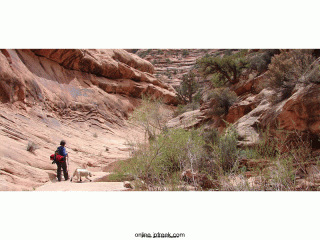Southeastern Utah is a gift for us all. The area has every thing an adventurer could ask for: Hiking, climbing, canyoneering, kayaking, mountain biking, and Jeep roads. The varied terrain includes snow-capped mountains, deep canyons, cedar forests, arid deserts, and miles of bedrock.
[Not a valid template]Although the choices are endless, we chose to explore the canyon country of Cedar Mesa and the Comb Ridge, discover ancient Native American ruins and learn about their culture, and as a bonus, drive a few Jeep roads at the Arch Canyon Jeep Jamboree. After being there a week, we barely scratched the surface of the this wonderful area.
Spring is a perfect time for southeast Utah. With cool mornings and warm afternoons, the weather was perfect for spending time outdoors and exploring the area. Upon arriving in Blanding, we were greeted by blue bird skies and snowcapped peaks. The air was so clear we could see the San Juan mountains of Colorado, still blanketed in winter snow, almost 100 miles away. After getting set up, the first thing that caught our eye was the Comb Ridge and the ancient cliff dwellings that dotted the eastern side. So we packed up the Jeep Rubicon and headed down the Butler Wash road. After a 13 mile bumpy ride, we spotted some ruins, parked, and headed off to explore. This first day, we would be directionally challenged and ultimately failed to find the ruins. However, it was a great hike and we returned the next day with renewed enthusiasm and better planning.
Getting to the trailhead (N37.36658 W109.63107) was fun and luckily we had the jeep to negotiate the one tricky section of the trail which had earlier thwarted a 4WD Toyota Tacoma. We drove through the section easily and began our hike with a close eye on our target in the distance. The hike involved a scenic trek up over the bedrock of Comb Ridge, through a spectacular canyon, and ended at the base of a magnificent cliff dwelling (N37.36587 W109.63985). This ancient dwelling was approximately 100 yards across and contained excellent examples of ancient Native American construction and culture. We observed pictographs and places where the Indians had used rocks to sharpen stones and grind corn. Afterward, we scaled the canyon walls and headed north to explore another dwelling and found some amazing petroglyphs (N37.36794 W109.64083) which are drawings etched into the rock. We took great care not to disturb or touch anything we discovered so that the beauty, history, and spirit of the dwellings and art would be undamaged for others to follow.
